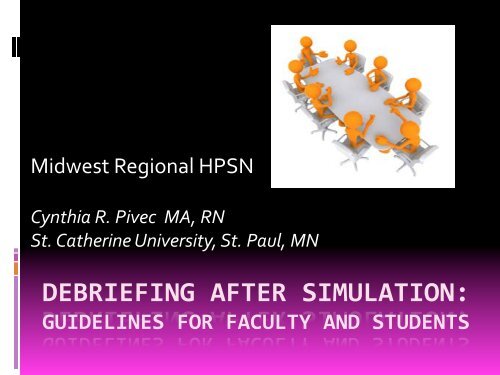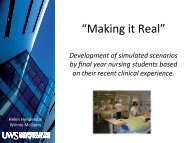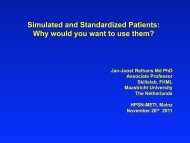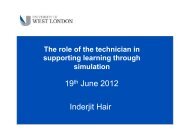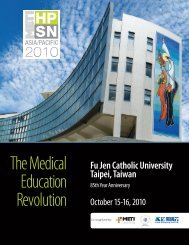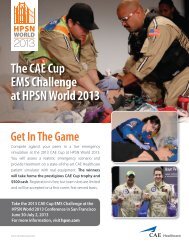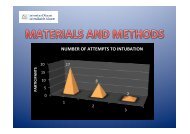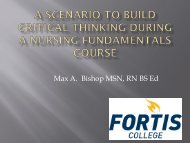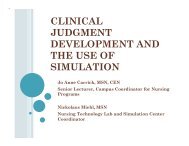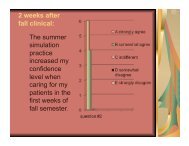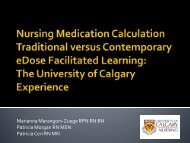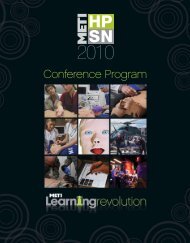debriefing after simulation - Human Patient Simulation Network
debriefing after simulation - Human Patient Simulation Network
debriefing after simulation - Human Patient Simulation Network
- No tags were found...
You also want an ePaper? Increase the reach of your titles
YUMPU automatically turns print PDFs into web optimized ePapers that Google loves.
Midwest Regional HPSN Cynthia R. Pivec MA, RN St. Catherine University, St. Paul, MN DEBRIEFING AFTER SIMULATION: GUIDELINES FOR FACULTY AND STUDENTS
<strong>Simulation</strong> Used for a long time in the health care field Used in nursing programs to enhance nursing education experience and as necessity Increased knowledge and skills needed for complex patient and changing healthcare Decrease in clinical time and settings
Debriefing An activity that follows a <strong>simulation</strong> experience led by a facilitator wherein feedback is provided on the <strong>simulation</strong> participants performance while positive aspects of the completed <strong>simulation</strong> are discussed and reflective thinking encouraged (National League for Nursing, 2010). Encourages reflective learning, which allows the participant to link theory to practice and research, think critically, and discuss how to intervene professionally in complex situations (Jeffries, 2010)
Debriefing Learning occurs in <strong>simulation</strong> through contextual task training and repetition, but significant learning occurs when deep insight is made explicit through reflection during <strong>debriefing</strong> (Driefuerst, 2009, p. 109)
Theory Reflective Practice and Experiential Learning Dewey Schon : reflect-‐in-‐action & reflect on-‐action Driefuerst: reflect-‐beyond-‐action Kolb: Concrete experimentation Reflective observation Abstract conceptualization Active experimentation
Literature Review – Debriefing in <strong>Simulation</strong> Growing literature on the use of <strong>simulation</strong> in healthcare and teaching nursing students. Debriefing is embedded in the <strong>simulation</strong> articles, but seldom the sole focus of research. Focuses on the active or doing part of <strong>simulation</strong>, development, and implementation. (Brackenreg, 2004; Nehring, Ellis, & Lashley, 2001; Seropian, 2003) Lacks the importance of the <strong>debriefing</strong> and the reflection piece of <strong>simulation</strong> Identifies <strong>debriefing</strong> as the most important part of the <strong>simulation</strong> (Becker, Rose, Berg, Park, & Shatzner, 2006; Childs & Sepples, 2006; Dismukes et al, 2006; Larew, Lessans, Spunt, Foster, & Covington, 2006; Lederman, 1992, Reese, Jeffries, & Engum, 2010; Sanford, 2010; Waxman, 2010)
Literature Review – Debriefing literature Research Found few research studies specific to <strong>debriefing</strong> Most important part, or the heart and soul, of <strong>simulation</strong> Essential for a successful learning experience Training the instructors is vital (Brackenreg, 2004; Cantrell, 2008; Dieckmann, Friis, Lippert, & Ostergard, 2009; Rall, Manser, & Howard, 2000; Shinnick, Woo, Horwich, & Steadman, 2011)
Literature Review – Concept Description/Concept analysis Describes the programs and insights in how they use and conduct <strong>debriefing</strong> Purpose is to give participants time to reflect and discuss the <strong>simulation</strong> experience and analyze, synthesize, and evaluate their actions (Anderson, 2008; Arafeh, Hansen, & Nichols, 2010; Ghauri, 2011; Jeffries, 2010). Reflection, emotion, reception, integration, and assimilation (Driefurst, 2009). Assimilation and accommodation where nursing students are able to transfer their knowledge from <strong>simulation</strong> to practice Using good judgment concept instead of judgmental <strong>debriefing</strong> (Rudolph, Simon, Rivard, Dufresne, & Raemer,2007)
Review of Literature – Characteristics of Debriefing Basic assumption is that everyone participating in <strong>simulation</strong> is intelligent, well trained, cares about doing their best, and wants to improve (Ghauri, 2011). Elements Environment Time Facilitator Student Role
Recommendations
Debriefing Process Faculty responsibilities Facilitate student reflection on events in scenario Enable students to understand how to improve Empower them to know that they can improve Ensure that students do not leave with misinformation Facilitator role Vary the role of facilitation by level Provide psychological safety by being trustworthy, respectful, confidential Provide honest feedback Develop <strong>debriefing</strong> skills to enhance the students perception of the <strong>simulation</strong> and learning Portray a positive demeanor
Debriefing Environment Create a positive, non-‐threatening, respectful, and confidential atmosphere Utilize a circle formation with all participants and facilitator at same eye level Videotape session if desired and refer to during <strong>debriefing</strong> Encourage participants to talk and discuss feelings, events, and transfer of knowledge Conduct in a different area than the <strong>simulation</strong> where students are out of the role which they played for <strong>simulation</strong>
Timing of Debriefing Conduct right <strong>after</strong> <strong>simulation</strong> so participants thoughts and emotions are present with <strong>debriefing</strong> lasting double or triple time of <strong>simulation</strong> Utilize the majority of time in <strong>debriefing</strong> for discussion and analysis of events Explore feelings and reactions of the event for the first 5-‐10 minutes, and summarize with transfer of information to the clinical setting in the last 5-‐10 minutes
Different Debriefing Models Different Debriefing Models and Identified Phases Found in the Literature FacultyDev.doc A process and defined model with phases: the three phases (Introduction, Middle, and Summary) of the NLN/SIRC model of <strong>debriefing</strong> with Kolbs Stages of Experiential Learning embedded in the Middle Phase. Questions in each phase to help facilitate discussion/dialogue
Debriefing Model: Phases • Introduction • Middle • Experiencing/Concrete Experience • Reflecting/Reflective Observation • Thinking/Abstract Conceptualization • Applying/Active Experimentation • Summary (Anderson, 2008; Brackenreg, 2004; Decker, 2007; Fanning & Gaba, 2007; Kolb, 2005; Mayo Clinic, n.d.)
Debriefing Process and Model Debriefing Process & Model Final Pivec.pdf
Debriefing Model for Student Use Student Debriefing Process & Model Pivec.pdf
<strong>Simulation</strong> Task Force Grant Renovation of lab space Purchase of iStan, Muse, Metivision, and other equipment Faculty development
RESPONSES TO A FACULTY DEVELOPMENT WORKSHOP ON SIMULATION LINDA M. BLAZOVICH DNP, RN, CNE
Literature Review: Faculty Development in Use of <strong>Simulation</strong> • Gap in literature – few research studies on faculty development regarding <strong>simulation</strong> • Findings that support value of faculty development ▫ INACSL Standards of Best Practice ▫ Barrier to use of <strong>simulation</strong> ▫ Workshops are a successful strategy
Faculty Workshop Development and evaluation of a two-‐day faculty workshop on <strong>simulation</strong> Descriptive study conducted to ask: Was faculty knowledge about <strong>simulation</strong> increased <strong>after</strong> participating in a <strong>simulation</strong> workshop? Was faculty skill in facilitating a <strong>simulation</strong> increased <strong>after</strong> participating in a <strong>simulation</strong> workshop? Were faculty attitudes regarding <strong>simulation</strong> improved <strong>after</strong> participating in <strong>simulation</strong> workshop?
Objectives of the Workshop Objectives: Increased knowledge Increased skill Improved attitude
Workshop Two days in length based on lit review Faculty preparation 3 articles 5 National League for Nursing SIRC modules Workshop content Based on an informal survey of small faculty group <strong>Simulation</strong>s based on Nursing Education <strong>Simulation</strong> Framework and the <strong>Simulation</strong> Design Template (Jeffries, 2007)
Workshop Agenda Didactic and discussion Faculty facilitation of <strong>simulation</strong> with <strong>debriefing</strong> Discussion / <strong>debriefing</strong> of the process Faculty from associate, baccalaureate, and graduate degree programs were invited to attend Thirty-‐nine chose to participate in the workshop
Instrument • Online survey (with Likert scale) to measure effectiveness of faculty development workshop • 2-‐4 months <strong>after</strong> workshop • Developed by researcher • Five questions in each of the following areas related to <strong>simulation</strong> ▫ Increase in knowledge ▫ Increase in skill ▫ Improvement in attitude • Each area became a composite group for analysis of the data
Results Sample: Nursing faculty who participated in a two day summer workshop on <strong>simulation</strong> 26/39 (67%) Demographics Program: AD 15%, Bacc 69%, Grad 12% (one didnt select) Years in nursing education: Ranged from [0-‐3] to[>20] median [4-‐10] Number of previous <strong>simulation</strong>s: Ranged from [0] to [6 or more], median [6 or more] Amount of previous <strong>simulation</strong> education attended: Ranged from [0] to [6 or more], median [1]
Results Related to Debriefing My skill in performing the role of facultyfacilitator during the <strong>debriefing</strong> increased.p=
Discussion Findings of study supported value of faculty development related to <strong>simulation</strong> Faculty development is essential to build faculty expertise and a quality <strong>simulation</strong> program It is important to assess faculty experience with <strong>simulation</strong>s to determine appropriate type and level of content
Recommendations • Assess faculty experience with <strong>simulation</strong> in planning for future workshops • Develop future workshops for faculty at St. Catherine University that address components of <strong>simulation</strong> in more depth (<strong>debriefing</strong>, evaluation) • Continue to use strategies of pre-assignments, presentations and discussions, & especially active participation because they were seen as enhancing faculty knowledge, skill, and attitude
The Last Survey or Two!
Student Survey on Debriefing Process and Pivec Debriefing Tool 57 students (26 juniors, 31 seniors) Role in <strong>simulation</strong> (17 nurse, 13 secondary nurse, 3 family member, 24 observer) STATEMENT I used the <strong>debriefing</strong> handout (tool) I wrote on the <strong>debriefing</strong> tool… …before <strong>debriefing</strong> to organize my thoughts …during <strong>debriefing</strong> to take notes I read the handout and used it as a guide Percent of Students 82% 77% 57% 57% 68%
STATEMENT Debriefing and the <strong>debriefing</strong> tool helped… …enhance my ability to participate in <strong>debriefing</strong> …clarify the purpose of <strong>simulation</strong> …me discuss my feelings …me describe and reflect on actual events …me think and analyze the <strong>simulation</strong> …clarify information from the <strong>simulation</strong> …me transfer information to clinical setting …me meet the objectives for the <strong>simulation</strong> Percent of Students 66% 68% 95% 93% 91% 84% 85% 73%
Students said… Organized my thoughts. Helped guide my thinking. As we ran out of time in actual sim, it gave us time to work through remaining steps and solve remaining problems. Helped to stay focused on important aspects of the <strong>simulation</strong>. I recalled info I observed during the sim and wrote down take away points.
Faculty Survey on Debriefing Process and Pivec Debriefing Handout 11 faculty (3 teach juniors, 8 teach seniors) STATEMENT I gave students <strong>debriefing</strong> handout (tool) I followed process on <strong>debriefing</strong> tool I asked students to write on tool… …before <strong>debriefing</strong> to organize their thoughts …during <strong>debriefing</strong> to take notes I asked students to read handout and use as a guide Percent of Faculty 82% 73% 82% 72% 18% 45%
STATEMENT Debriefing and the <strong>debriefing</strong> tool helped me … … enhance my ability to facilitate <strong>debriefing</strong> … enhance student ability to participate in <strong>debriefing</strong> Debriefing and the <strong>debriefing</strong> tool helped students … … clarify the purpose of <strong>simulation</strong> … discuss feelings … describe and reflect on actual events … think and analyze the <strong>simulation</strong> … clarify information from the <strong>simulation</strong> … transfer information to clinical setting … meet the objectives for the <strong>simulation</strong> Percent of Faculty 64% 66% 90% 73% 90% 90% 64% 91% 82%
Faculty said… It greatly assisted me in conducting the <strong>debriefing</strong> in an organized and thoughtful manner. It provides a structured way of examining the sequence of events in the <strong>simulation</strong>. I didnt necessarily go in order – given the conversation I jumped around a bit – the questions were very helpful.
<strong>Simulation</strong> You will now facilitate and participate in the <strong>debriefing</strong> <strong>after</strong> viewing the <strong>simulation</strong> Student Objectives: Provide safe care to multiple patients Assess patient and prioritize appropriate interventions Communicate with other health professional using SBAR Nursing <strong>Simulation</strong> Scenario Medical Error -‐ YouTube.flv
<strong>Simulation</strong> is not what you do. Its what you learn. Jane Murray and Ann Huitson Northumbria University
Debrief the Debriefing!ExperiencingReflectingThinkingApplyingThank you for your attendance andparticipation
References Anderson, M. (2008) Debriefing and guided reflection. Accessed April 28, 2001. Retrieved from, http://sirc.nln.org/mod/ Arafeh, J., Hansen, S., & Nichols, A. (2010). Debriefing in simulated-‐based learning: facilitating a reflective discussion. Journal of Perinatal & Neonatal Nursing, 24(4), 302-‐311. Brackenreg, J. (2004). Issues in reflection and <strong>debriefing</strong>: How nurse educators structure experiential activities. Nurse Education in Practice, (4), 264-‐270. Doi: 10.1016/j.nepr.2004.01.005 Becker, K. L., Rose, L. E., Berg, J. B., Park, H. & Shatzer, J. H. (2006). The teaching effectiveness of standardized patients. Journal of Nursing Education, 45(4), 103-‐111. Benner, P., Surphen, M., Leonard, V., & Day, L. (2010). Educating nurses: A call for radical transformation. San Fransisco: Jossey-‐Bass. Cantrell, M. A. (2008). The importance of <strong>debriefing</strong> in clinical <strong>simulation</strong>s. Clinical <strong>Simulation</strong> in Nursing, 4(2). doi: 10.1016/j.ecns.2008.06.006 Cantrell, M. A., & Deloney, L. A. (2007). Integration of standardized patient <strong>simulation</strong>. Anesthesiology Clinics, 25(2), 377-‐383. doi:10.1016/j.anclin.2007.03.003 Carper, B. A. (1978). Fundamental patterns of knowing in nursing. Advances in Nursing Science, I(1), 13-‐23. Childs, J., & Sepples, S. (2006). Clinical teaching by <strong>simulation</strong> lessons learned from a complex patient care scenario. Nursing Education Perspectives, 27(3), 154-‐158. doi: 10.1043/1094-‐ 2831(2006)027[0154:CTBSLL]2.0.CO;2 Crookall, D. (2010). Serious games, <strong>debriefing</strong>, and <strong>simulation</strong>/gaming as a discipline. <strong>Simulation</strong> & Gaming, 41(6), 898-‐920. doi: 10.1177/1046878110390784 Decker, S. (2007). Integrated guided reflection into simulated learning experiences. In P. R. Jeffries (ed), <strong>Simulation</strong> in nursing: From conceptualization to evaluation (pp. 73-‐85). New York: National League for Nursing. Decker, S. (2009). Until we meet. Debra L. Spunt Lecture Slides. Retrieved April 8, 2011 from http://sirc.nln.org/ Dewey, J. (1933). How we think: A restatement of the relation of reflective thinking into the educative process. Lexington, KY: D.C. Heath.
References continued.. Dieckmann, P., Friis, S. M., Lipperst, A., & Ostergaard, D. (2009). The art and science of <strong>debriefing</strong> in <strong>simulation</strong>: Ideal and practice, Medical Teacher, 31(7), e287-‐295. Retrieved from http://www.ncbi.nlm.nih.gov/pubmed?term=Dieckmann%2C%20P.%2C%20Friis%2C%20S.%20M.%2C%20Lipperst%2C%20A.%2C%20%26%20Ostergaard%2C%20D.%20(2009).%20The%20art%20and%20science%20of%20 Dismukes, R. K., Gaba, D. M., & Howard, S. K. (2006). So many roads: Facilitated <strong>debriefing</strong> in healthcare. <strong>Simulation</strong> in Healthcare: The Journal of the Society for medical <strong>Simulation</strong>, 1(1), 23-‐25. Dreifuerst, K. (2009). The essentials of <strong>debriefing</strong> in <strong>simulation</strong> learning: A concept analysis. Nursing Education Perspectives, 30(2), 109-‐114. Fanning, R. & Gaba, D. (2007). The role of <strong>debriefing</strong> in <strong>simulation</strong> – based learning. <strong>Simulation</strong> in Healthcare, 2(2), 115-‐125. doi: 10.1097/SIH.0b013e3180315539 Galloway, S. (2009). <strong>Simulation</strong> techniques to bridge the gap between novice and competent healthcare professionals. Online Journal of Issues in Nursing, 14(2), 1-‐9. Garrett, B., MacPhee, M., & Jackson, C. (2010). High-‐fidelity patient <strong>simulation</strong>: Considerations for effective learning. Nursing Education Perspectives, 31(3), 309-‐313. Ghauri, B. (2011, March). Debriefing with your pants on. PowerPoint presented at the Drexel University Conference: <strong>Simulation</strong> in Healthcare, Orlando, Florida. Jeffries, P. R. (Ed.). (2007). <strong>Simulation</strong> in nursing education: From conceptualization to evaluation. New York: National League for Nursing. Jeffries, P. (2010, October). The art of <strong>debriefing</strong>: How to conduct a guided reflection and its importance. PowerPoint presented at the National League of Nursing Conference, Las Vegas, Nevada. Kolb, D. A. (2005). The Kolb Learning Style Inventory (Version 3.1). Boston, MA: Hay Group. Larew, C., Lessans, S., Spunt, D., Foster, D. & Covington, B. (2006). Innovations in clinical <strong>simulation</strong>: Application of Benners theory in an interactive patient care <strong>simulation</strong>. Nursing Education Perspectives (27), 16-‐21.
References continued….. Lasater, K. (2007a). High-‐fidelity <strong>simulation</strong> and the development of clinical judgment: Students experiences. Journal of Nursing Education, 46(6), 269-‐276. Lasater, K. (2007b). Clinical judgment development: Using <strong>simulation</strong> to create an assessment rubric. Journal of Nursing Education, 46(11), 496-‐503. Lederman LC. (1992) Debriefing: Toward a systematic assessment of theory and practice. <strong>Simulation</strong> and Gaming, 23(2), 145-‐160. Mayo Clinic (n.d.). Basic <strong>debriefing</strong> principles. Retrieved February 5, 2011 from http://www.mayo.edu/<strong>simulation</strong>center/Instructor_Development-‐Course.html McDonnell, L. K., Jobe, K. K., & Dismukes, R. K. (1997). Facilitating LOS <strong>debriefing</strong>s: A training manual. Retrieved February 5, 2011, from http://human-‐factors.arc.nasa.gov/flightcognition/Publications/Final_Training_TM.pdf National League for Nursing (2008). <strong>Simulation</strong> innovation resource center (SIRC) glossary. Retrieved from http://sirc.nln.org/ Nehring, W., & Lashley, F. (2009). Nursing <strong>simulation</strong>: A review of the past 40 years. <strong>Simulation</strong> Gaming, 40(4), 528-‐532. doi: 10.1177/1046878109332282 Nehring, W., Ellis, W., & Lashley, F. (2001). <strong>Human</strong> patient simulators in nursing education: An overview. <strong>Simulation</strong> Gaming, 32(2), 194-‐204. DOI: 10.1177/104687810103200207 Owen, H. and Follows, V. (2006). GREAT <strong>simulation</strong> <strong>debriefing</strong>. Medical Education, 40, 488–489. doi: 10.1111/j.1365-‐2929.2006.02421.x Petranek, C. F., & Corey, S., & Black, R. (1992). Three levels of learning in <strong>simulation</strong>s: Participating, <strong>debriefing</strong>, and journal writing. <strong>Simulation</strong> & Gaming, 23(2), 174. Peters, V. A., & Vissers, G. A., (2004). A simple classification model for <strong>debriefing</strong> <strong>simulation</strong> games. <strong>Simulation</strong> & Gaming, 35(70), 70-‐84. doi: 10.1177/1046878103253719
References continued.. Rall, M., Manser, T., & Howard, S.K. (2000). Key elements of <strong>debriefing</strong> for simulator training. European Journal of Anaesthesiology, 17(5), 516-‐517. DOI: 10.1046/j.1365-‐2346.2000.00724-‐1.x Reese, C. E., Jeffries, P. R., & Engum, S. A. (2010). Learning together: Using <strong>simulation</strong> to develop nursing and medical student collaboration. Nursing Education Perspectives, 31(1), 33-‐37. Rothgeb, M. (2008). Creating a nursing <strong>simulation</strong> laboratory: A literature review. Journal of Nursing Education, 47(11), 489-‐494. Rudolph, J., Simon, R., Rivard, P., Dufresne, R. & Raemer, D. (2007). Debriefing with good judgment: Combining rigorous feedback with genuine inquiry. Anesthesiology Clinics (25), 361-‐376. Sanford, P. (2010). <strong>Simulation</strong> in nursing education: A review of the research. The Qualitative Report, 15(4), 1006-‐1011. Retrieved from http://www.nova.edu/ssss/QR/QR15-‐ 4/sanford.pdf Schon, D. A. (1983). The reflective practitioner: How professionals think in action. New York: Basic Books. Seropian, M. (2003). General concepts in full scale <strong>simulation</strong>: Getting started. Anesthesiology & Analgesia (97), 1695-‐1705. Shinnick, M. A., Woo, M., Horwich, T. B., & Steadman, R. (2011, May). Debriefing: The most important component in <strong>simulation</strong>? Clinical <strong>Simulation</strong> in Nursing, 7(3), e105-‐e111. doi:10.1016/j.ecns.2010.11.005. Waxman, K. (2010). The development of evidence based clinical <strong>simulation</strong> scenarios: Guidelines for nurse educators. Journal of Nursing Education (49), 29-‐35. Wotton, K., Davis, J., Button, D., & Kelton, M. (2010). Third-‐Year Undergraduate Nursing Students' Perceptions of High-‐Fidelity <strong>Simulation</strong>. Journal of Nursing Education, 49(11), 632-‐639. doi:10.3928/01484834-‐20100831-‐01 Zigmont, J., Kappus, L., & Sudikoff, S. (2011). The 3D Model of Debriefing: Defusing, Discovering, and Deepening. Seminars In Perinatology, 35(2), 52-‐58.
Thank you for your attendance and participation. Please contact us with any questions or comments. crpivec@stkate.edu lmblazovich@stkate.edu


